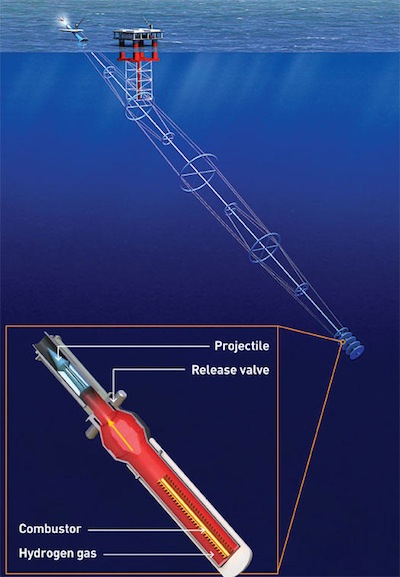Science Fiction
Dictionary
A B C D E F G H I J K L M N O P Q R S T U V W X Y Z
Quicklauncher Space Cannon

Quicklauncher is a space-cannon proposed by Lawrence Livermore National Laboratory physicist John Hunter. This 3,600-foot gun could make deliveries to an orbiting space station for just $250 per pound - compared to $5,000 per pound costs for delivery by rocket.

()
Hunter wants to operate the gun, the “Quicklauncher,” in the ocean near the equator, where the Earth’s fast rotation will help slingshot objects into space. A floating cannon—dipping 1,600 feet below sea level and steadied by a ballast system—would let operators swivel it for different orbits.Next month, Hunter will test a functional, 10-foot prototype in a water tank. He says a full-size launcher could be ready in seven years, provided the company can round up the $500 million. Despite the upfront cost, Hunter says he has drawn interest from investors because his reusable gun saves so much cash in the long haul.
Just don’t ever expect a ride in the thing: The gun produces 5,000 Gs, so it’s only for fuel tanks and ruggedized satellites. “A person shot out of it would probably get compressed to half their size,” Hunter says. “It’d be over real quick.”
In theory, it works like this: First, the gun combusts natural gas in a heat exchanger within a chamber of hydrogen gas. Operators open the valve, and the hot hydrogen expands down the tube, boosting the payload, which exits the mouth of the gun at 13.000 mph.
Here's a complete talk presented at Google in December, 2009 by John Hunter.
(John Hunter presents Quicklauncher space-cannon)
Jules Verne famously elaborates on the idea of a space-cannon in his excellent 1867 novel From the Earth to the Moon; here's the proposal for the Columbiad:
"You know," said he, "what progress artillery science has made during the last few years, and what a degree of perfection firearms of every kind have reached. Moreover, you are well aware that, in general terms, the resisting power of cannon and the expansive force of gunpowder are practically unlimited.Well! starting from this principle, I ask myself whether, supposing sufficient apparatus could be obtained constructed upon the conditions of ascertained resistance, it might not be possible to project a shot up to the moon?
...I have looked at the question in all its bearings, I have resolutely attacked it, and by incontrovertible calculations I find that a projectile endowed with an initial velocity of 12,000 yards per second, and aimed at the moon, must necessarily reach it. I have the honor, my brave colleagues, to propose a trial of this little experiment."
From Popular Science via Next Big Future.
Scroll down for more stories in the same category. (Story submitted 1/15/2010)
Follow this kind of news @Technovelgy.| Email | RSS | Blog It | Stumble | del.icio.us | Digg | Reddit |
Would
you like to contribute a story tip?
It's easy:
Get the URL of the story, and the related sf author, and add
it here.
Comment/Join discussion ( 5 )
Related News Stories - (" Space Tech ")
Will Space Stations Have Large Interior Spaces Again?
'They filed clumsily into the battleroom, like children in a swimming pool for the first time, clinging to the handholds along the side.' - Orson Scott Card, 1985.
Reflect Orbital Offers 'Sunlight on Demand' And Light Pollution
'I don't have to tell you about the seven two-mile-diameter orbital mirrors...'
Chrysalis Generation Ship to Alpha Centauri
'This was their world, their planet —
this swift-traveling, yet seemingly moveless vessel.' - Nat Schachner, 1934
The First Space Warship For Space Force
'Each of the electrical ships carried about twenty men...' - Garrett P. Serviss, 1898.
Technovelgy (that's tech-novel-gee!) is devoted to the creative science inventions and ideas of sf authors. Look for the Invention Category that interests you, the Glossary, the Invention Timeline, or see what's New.
Science Fiction
Timeline
1600-1899
1900-1939
1940's 1950's
1960's 1970's
1980's 1990's
2000's 2010's
Current News
The Zapata Air Scooter Would Be Great In A Science Fiction Story
'Betty's slapdash style.'
Thermostabilized Wet Meat Product (NASA Prototype)
There are no orbiting Michelin stars. Yet.
Could Crystal Batteries Generate Power For Centuries?
'Power could be compressed thus into an inch-square cube of what looked like blue-white ice'
India Ponders Always-On Smartphone Location Tracking
'It is necessary... for your own protection.'
Amazon Will Send You Heinlein's Knockdown Cabin
'It's so light that you can set it up in five minutes by yourself...'
Is It Time To Forbid Human Driving?
'Heavy penalties... were to be applied to any one found driving manually-controlled machines.'
Replace The Smartphone With A Connected Edge Node For AI Inference
'Buy a Little Dingbat... electropen, wrist watch, pocketphone, pocket radio, billfold ... all in one.'
Artificial Skin For Robots Is Coming Right Along
'... an elastic, tinted material that had all the feel and appearance of human flesh and epidermis.'
Robot Guard Dog On Duty
I might also be thinking of K-9 from Doctor Who.
Wearable Artificial Fabric Muscles
'It is remarkable that the long leverages of their machines are in most cases actuated by a sort of sham musculature...'
BrainBridge Concept Transplant Of Human Head Proposed
'Briquet’s head seemed to think that to find and attach a new body to her head was as easy as to fit and sew a new dress.'
Google's Nano Banana Pro Presents Handwritten Math Solutions
'...copy was turned out in a charming and entirely feminine handwriting.'
Edible Meat-Like Fungus Like Barbara Hambly's Slunch?
'It was almost unheard of for slunch to spread that fast...'
Sunday Robotics 'Memo' Bot Has Unique Training Glove
'He then started hand movements of definite pattern...'
Woman Marries Computer, Vonnegut's Dream Comes True
'Men are made of protoplasm... Lasts forever.'
Natural Gait With Prosthetic Connected To Nervous System
'The leg was to function, in a way, as a servo-mechanism operated by Larry’s brain...'
